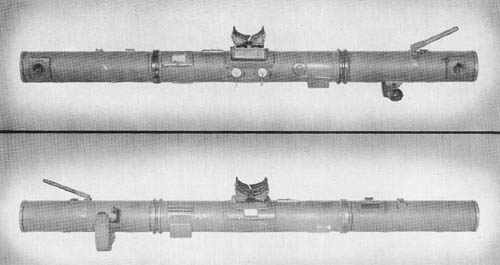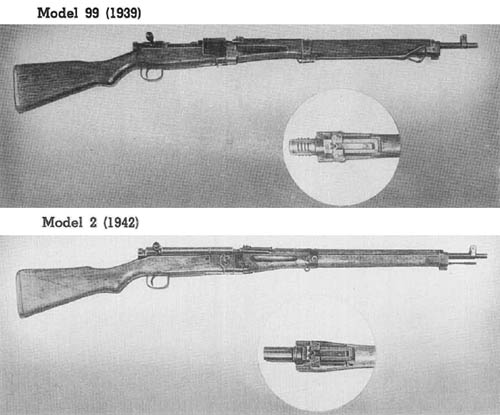
Both of the weapons shown above are basically the same as the Japanese 7.7 mm standard infantry rifle, Model 99. They have been designed, however, to incorporate a takedown feature which enables them to be used by paratroop units. Manufactured at Nagoya Arsenal, they are manually-operated, bolt-action, magazine-fed, clip-loaded rifles.
The modified Model 99 differs from the basic weapon in the following respects: the barrel locking adaptor is secured to the receiver; the barrel is secured into the adaptor by interrupted screw threads; the bolt handle is detachable; and the stock is in two parts.
The Model 2, called “Teraju” by the Japanese, is of much better workmanship than the Modified Model 99. The barrel and front end are detached from the stock at the receiver ring. When taken down, the barrel section is 25 1/2 inches long; the stock 20 1/4inches. Total weight of the loaded weapon is 8.9 pounds. The takedown system is simple and sturdy. The barrel has a straight, unthreaded shank with a lug on the bottom. The shank fits into a socket in front of the receiver. A tapered locking key passes through the receiver (from right to left) and engages in front of the barrel lug. The key cannot be taken out completely, but may be withdrawn far enough to allow removal of the barrel. It is locked in place by screwing a nut on the right side into the receiver wall.
A spring actuated plunger located in the front end of the buttstock locks the barrel and forestock in position. This plunger must be retracted before the barrel can be rotated for takedown.
SPECIFICATIONS
| Weight | 8.9 lbs. | |
| Length | 44″ | |
| Principle of operation | Manual, bolt-operated | |
| Feeding device | Clip | |
| Capacity of feeding device | 5 rounds | |
| Ammunition types | Model 99 rimless | |
| Type of sight | Front: inverted “V” blade on “T” base; Rear: leaf graduated from 328 to 1,640 yds. with aperature sight and aperture battle sight side arms for A.A. fire. | |
| Weight of barrel | ||
| Length of barrel | 25 7/8″ | |
| Length of rifling | ||
| Rifling: | ||
| Twist | Uniform, right hand; one turn in approx. 10 ins. | |
| Form | Metford segmental | |
| No. of grooves | 4 | |
| Depth of grooves | ||
| Width of grooves | ||
| Chamber pressure | ||
| Muzzle velocity | 2,360 f/s | |
| Maximum range | 3,000 yds. | |
| Effective range | 600 yds. |
Japanese: p. 212.1 (May 1, 1945)
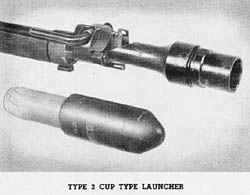 The Type 2, which is patterned after the German grenade launcher of the same type, fits over the front sight of the rifle and has a short rifled barrel. It fires both the
The Type 2, which is patterned after the German grenade launcher of the same type, fits over the front sight of the rifle and has a short rifled barrel. It fires both the 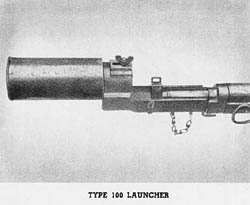 The Type 100 may be used with either the
The Type 100 may be used with either the 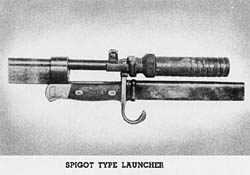 The spigot type launcher, which may be used with either the Type 38 or Type 99 rifle, fires the Type 91, Type 3 H.E., and several types of smoke and incendiary grenades. It consists of a rifled barrel threaded to an adapter. The launcher is attached to the rifle at the rear of the front sight mount by two locking arms on the adapter. When a bayonet is fixed to the rifle, additional stability is obtained by the use of a two-pronged lug on the adapter which fits on the bayonet guard.
The spigot type launcher, which may be used with either the Type 38 or Type 99 rifle, fires the Type 91, Type 3 H.E., and several types of smoke and incendiary grenades. It consists of a rifled barrel threaded to an adapter. The launcher is attached to the rifle at the rear of the front sight mount by two locking arms on the adapter. When a bayonet is fixed to the rifle, additional stability is obtained by the use of a two-pronged lug on the adapter which fits on the bayonet guard.